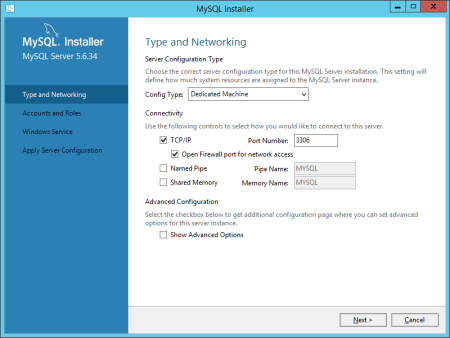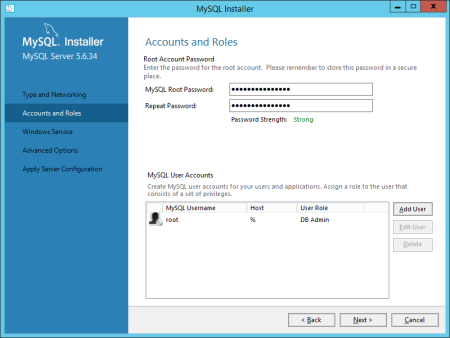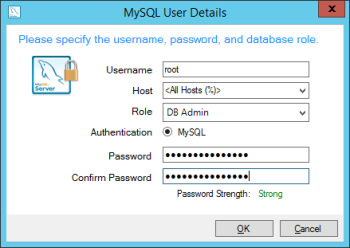
Prior to installing MySQL Server, complete the installation requirements (see Requirements for your Database Software).
To install and configure MySQL Server on a Windows system, complete the steps below. For another platform, see your MySQL Server documentation.
To install and configure MySQL Server:
| 1. | In the License Agreement page of the MySQL Installer, read the terms of the Oracle software license, select I accept the license terms, and click Next. |
| 2. | In the Choosing a Setup Type page, select Server only and click Next. |
| 3. | In the Installation page, click Execute. |
| 4. | Upon completion of the installation process, click Next. |
| 5. | In the Product Configuration page, click Next. |
| 6. | In the Type and Networking page (see Figure 2): |
| a. | From the Config Type drop-down, select Dedicated Machine. |
| b. | Select Open Firewall port for network access. |
| c. | Click Next. |
Figure 2. Type and Networking page

| 7. | In the Account and Roles page (Figure 3): |
| a. | In the Root Account Password fields, enter a password of your choice for the root MySQL user account that will access TLC. |
| b. | Click Add User. |
| c. | Complete the MySQL User Details page (see Figure 4) and click OK. |
| d. | In the Account and Roles page, click Next. |
Figure 3. Account and Roles page

Figure 4. MySQL User Details page

| 8. | In the Windows Service page, click Next. |
| 9. | In the Apply Server Configuration page, click Execute. |
| 10. | Upon completion of the configuration process, click Finish. |
| 11. | In the Product Configuration page, click Next. |
| 12. | In the Installation Complete page, click Finish. |
To optimize the performance of MySQL Server with Tripwire Log Center:
| 1. | In the directory in which you installed MySQL Server, open the MySQL configuration file (my.ini). |
| 2. | Copy the following lines into the configuration file: |
default-storage-engine=MyISAM
delayed_insert_limit=25000
delayed_queue_size=25000K
key_buffer_size=<key_buffer_size>M
sort_buffer_size=256K
query_cache_size=0
read_buffer_size=<read_buffer_size>K
read_rnd_buffer_size=<read_rnd_buffer_size>K
where <key_buffer_size> is 20-30% of available RAM,
<read_buffer_size> is 1/16th of available RAM, and
<read_rnd_buffer_size> is 1/8th of available RAM.